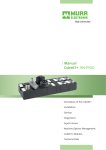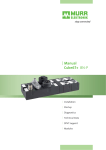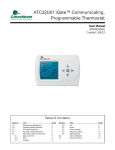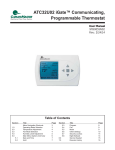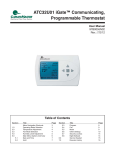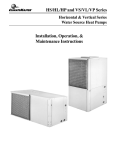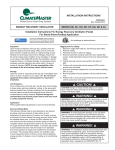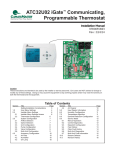Download ClimateMaster DC Series Product specifications
Transcript
CMC 2000 Series Electronic Controller Version 9.0 TEST SHI GND 24V NN+ USD CSD ESD GND LOW MED HI C L X G Y1 W1 R Installation, Operating & Maintenance Instructions C2 LTS P2 HPS LPS P3 P4 C3 C4 24 VAC ON 1 2 3 4 5 6 7 8 WV CLIMATEMASTER COND FAULT LED's RV STG2 FAN HIGH RELAY MED FAN LO FAN S/N WV RELAY L1 L2 ** LO COMP. RELAY R.V. RELAY MED Page 1 TABLE OF CONTENTS Page Page 2 Introduction 3 General Information 4 Overview 4 General Operating Parameters 4 Relay Ratings 4 Optional Components 4 Revision Identification 4 Features 4 Installation of Power Wiring 4 Single Phase Equipment 5 Three Phase Equipment and Single Phase over 10 AMPS 5 Unit Operation 5 Powering Up Unit 5 Normal Operation 5 Thermostat Inputs 5 R-HI-ME-LO Fan Speed Select 6 Dip Switch Settings 6 Energy Management Operation Modes 6 Safety Features 6 Fault Indications and Diagnostic LEDs 6 Maintenance 7 Test Mode 7 Interfacing the CMC 2000 Controller 7 Interfacing the CMC 2000 Series Controller to External Equipment 8 Replacing a Controller Board 8 Parts List 8 Trouble Shooting Chart: CMC 2000 Controllers 9 Control Board Trouble Shooting 11 Control Board Diagnostic Chart 11 CMC 2000 Series Controller Board Layout 12 INTRODUCTION This Installation and Operation manual is for ClimateMaster CMC 2000 Series Electronic Controller (CMC). ClimateMaster CMC Controllers are typically factory installed within the control section of the ClimateMaster HVAC equipment and are shipped with the unit. Sensors and other peripherals are typically shipped loose in the same carton for field installation. Features Electro-Mechanical ClimateMaster offers three standard electronic controller configurations of the CMC Controller to allow flexible matching of controller features to application requirements. Refer to the table below to determine the features available in the CMC Controller to be installed. High Pressure Protection S Electronic CMC-2001 S Electronic CMC-2005 S Electronic CMC-2010 S Low Pressure Protection S S S S Low Refrigerant Gas Protection S S S S Low Water Flow Protection S S S S Room Temperature Set Point - In Room S S S S S S S Room Temperature Set Point - Remote Display Room Temperature - In Room S* S Display Room Temperature - Remote S* Demand Load Shed O S S S Low Voltage Protection O S S S High Voltage Protection O S S S Emergency Shutdown O S S S Random Start O S S S Anti-Short-Cycle Time-Delay O S S S Condensate Overflow Switch O S S S Intelligent Re-Set O S S S Quick Service Test S S S Reduced Reversing Valve Operation S S S S LED Status Lights O S S Night Setback O S S S Night Setback Override - Remote Night Setback Override - Local S* O S High/Low Fan Speed Pump Restart O O S S S O* S O Compressor Run Hours S* Compressor Starts S* Fan Run Hours S* Remote Alarm S* Local Alarm O O O O Local Alarm For Condensate Overflow O O O S* U U Remote Alarm For Condensate Overflow O* RS-485 Communication S Outdoor-Air Damper-Control O E E E Motorized Water Valve O E E E Totally-Automated Building Interface O* Leaving Water Temperature Display O* Multiple Units On One Thermostat 3 3 3 Leaving Air Temperature Display S = Standard Feature O* O = Optional Feature U = Upgrade E = either Outdoor-Air Damper-Control or Motorized Water Valve can be selected, but not both. *This feature requires a personal computer to link to the system with the required compatible software. Page 3 GENERAL INFORMATION Overview This manual includes discussion on the following controller options: Centralized communications via Direct Digital Control (DDC); Diagnostics; Fan speed control; Energy management functions; Controller use with electronic programmable thermostats; Controller use with damper or water valve electric operators. General Operating Parameters Controllers with a serial number which begins with the letter "E" and has part number 69626500 stamped above the serial number is an "E" Revision Board. Please consult the IOM literature, part number 69626510, for details. Features The CMC 2000 Series controller offers the following features which improve the operation and safety of water source heat pump systems: The following are general operating parameters for the CMC 2000 Series Controller: • Anti-short cycle protection Operating Environment: 40° F (4.4° C) to 140° F (60° C) 5 to 95% relative humidity, non-condensing. • High and low voltage cutouts Storage Environment: 0° F (-18° C) to 158° F (70° C) 5 to 95% relative humidity, non-condensing. • Random start Power Requirements: A dedicated 24 VAC, 50-60 Hz, 1 PH, 40 VA transformer is required. • High and low pressure cutouts • Low water temperature (freeze) protection • Quiet reduced cycling reversing valve operation • Diagnostic LED’s • Reset lockout at unit or at disconnect Relay Ratings The following relays are included with the CMC 2000 Series Controller, part number 69626512: • Compressor Relay; 2 HP at 277 VAC • Intelligent reset • Condensate overflow sensor • Ability to work with any heat/cool electronic or electromechanical thermostat. • Fan High Speed Relay; 2 HP at 277 VAC • Night set back, compressor shut down and emergency shut down. • Reversing Valve Relay; 5 Amps at 24 VAC • Elimination of time delays for field servicing • Water Valve Relays: 5 Amps at 24 VAC • RS-485 communications (Optional) • Three-speed fan control (Optional) Optional Components The following optional components are available on the CMC 2000 Series Controller, part number 69626513: • Fan Medium, Low Speed Relay: 3/4 HP at 277 VAC • Damper control relay (Optional) • Electronic room sensor (Optional) Installation of Power Wiring ! WARNING ▲ Optional RS-485 Communications See CMC Series, Electronic Controller Version 8.9 Communications Option Installation, Operating and Maintenance Manual, part number 69626514, for details. Revision Identification A Version 8.9 controller is identified by a serial number greater than 30,000 and the part number 69626512 (or part number 69626513) stamped above the serial number. Controllers with a serial number less than 10,000 and part number 69183000 stamped above the serial number is a "D" Revision Board. Consult factory for details. Page 4 All wiring must comply with the National Electric Code and all local codes. CAUTION: The CMC 2000 Series Controller uses static sensitive CMOS components which may be damaged by static. To prevent damage to the components during service, DO NOT TOUCH CIRCUIT BOARD COMPONENTS. HOLD THE CIRCUIT BOARD BY THE EDGES ONLY. Single-Phase Equipment Wire Single-Phase equipment requiring less than 10 amps at 240 VAC (2.4 kva) as follows: 1. 2. 3. Connect the incoming main power from an NEC or local code approved disconnect device to terminals L1 and L2 on the control board. Refer to the wiring diagram attached to the unit. Connect a ground wire from the power source. Earth-ground couple to the chassis ground screw is provided in the control box. Use copper conductors only. Do not run the AC power wiring in the same conduct with low voltage wiring. Three-Phase Equipment and Single-Phase over 10 AMPS: Wire Three-Phase equipment and Single-Phase equipment requiring 10 amps or more at 240 VAC (2.4 kva) as follows: 1. Connect the incoming main power from an NEC approved disconnect device to the line voltage connections in the control box. Refer to the wiring diagram attached to the unit. 2. Connect a ground wire from the power source. Earthground couple to the chassis ground screw is provided in the control box. Use copper conductors only. 3. Do not run the AC power wiring in the same conduct with low voltage wiring. UNIT OPERATION Powering up Unit Turn on power. Verify that the green LED light is illuminated. The following conditions indicate that a fault may be present. • Green LED is not illuminated (located below dip switch - Version E) • Four (4) alarm LED's are blinking • One (1) alarm LED is illuminated Refer to diagnostic and Control Board Trouble Shooting charts on pages ?-?. Normal Operation The Controller operates in normal mode when the green LED is illuminated to indicate power is applied and no alarm LED’s are illuminated or blinking. Thermostat Inputs R - G Fan Only - The fan energizes when a closure occurs. On units without fan speed control, the closure is controlled by the tap at the motor wired to meet the installation requirements. On units where the fan speed option has been supplied, closure occurs at the speed selected. R - Y Cooling - The first time a closure occurs, the fan starts immediately unless one of the Hi, Me, Lo inputs are activated, due to the fan switch on the thermostat. The water valve relay is then energized, which is followed by a 5 to 80 second random start delay. At this time, a 20 second fixed delay is applied, after which the reversing valve is energized. One second later, the compressor is energized. When the input opens, the compressor is de-energized. One second later the water valve is de-energized. After an additional 30 seconds, the fan is de-energized unless one of the Hi, Me, Lo inputs are activated. On all subsequent closures, the sequence is the same as for the initial closure except that the 5 to 80 second random start delay is omitted, and the reversing valve remains in the cooling mode until the first demand for heating. NOTE: The compressor energizes 20 seconds after the water valve and the fan are energized unless the controller has damper option selected. (See dip switch #6) If the damper option is selected, the water valve relay is energized 30 minutes after the compressor first start-up at initial power on or the deactivation of the USD setback function. R - W Heating - R-Y Heating operations follow the same sequence of functions as R-Y Cooling except that the reversing valve is de-energized during the heating mode and remains de-energized until the first demand for cooling. R - L Night Setback (Unoccupied) Override - A momentary closure between R and L returns the unit to the occupied mode for 2 hours. At the end of this 2 hour period, the unit returns to the unoccupied mode. If the closure between R and L is continuous, the controller Page 5 acts as if a thermostat is connected and returns the unit to continuous heat until the thermostat is satisfied. NOTE: To reset the board at the thermostat, the fan switch on the thermostat must be in the "AUTO" position. R-HI-ME-LO Fan Speed Select (Optional) CAUTION: After changing dip switch settings, turn the unit off at the disconnect and power up to initiate the new unit settings. Fan Speed Control (Optional) - Fan speed is manually selected at the thermostat for high medium or low The selected speed provides contact closure between R-Hi or R-Me or R-Lo to activate the fan. Consult equipment blower performance tables in the product specifications for air volume and pressure characteristics typical of each speed. Select the speed which allows the blower to overcome any excess static pressure drop from ductwork, registers or grilles connected to unit supply or return opening. Dip Switch Settings Dip Switch #1-2 - Only used when an ET Series Thermostat is connected to the CMC Controller. Use dip switches to set addresses for multi-stage or multiple CMC boards connected to one ET Series Thermostat. For master/slave applications, (maximum of three CMC boards connected to one ET Thermostat), each CMC board shall have identical addresses. For two stage heat pump, which have two CMC boards, or for multi-stage control, address first CMC board by placing dip switch #1 "OFF", dip switch #2 "ON". Address second CMC board by placing dip switch #1 "ON" and dip switch #2 "OFF". For a third controller, set both dip switches "OFF". Dip Switch #3 - For DDC option only. "ON" - When ET Series Thermostat is connected to the CMC board. "OFF" - When a space sensor is connected to the CMC board. Dip Switch #4 - "ON" - ˚F. "OFF"- C. For DDC option only (Version 8.9 or higher one.) Dip Switch #5 - "ON" - Fan shall stop when heat pump is in a fault mode. "OFF" - Fan continues to operate in a fault mode. Dip Switch #6 - "ON" - Auxiliary relay for pump restart or motorized valve option is energized 20 seconds prior to compressor energization. "OFF" - Auxiliary relay for damper option opens 30 minutes after USD returns to occupied mode. Dip Switch #7- "ON" - Safety contacts LTS, LPS and HPS are normally open. "OFF" - Safety contacts LTS, LTS and HPS are normally closed. Dip Switch #8- "ON" - Resets board from main power switch on a console unit. A horizontal or vertical unit, reset is accomplished by momentarily turning the system switch to the "OFF" position at the thermostat. "OFF" Reset function by cycling the main power only. Page 6 Energy Management Operation Modes Load Shedding - (CSD Terminal) When the CSD terminal is connected to a chassis ground through an external contact closure, the compressor is stopped. When the contact opens, the compressor returns to control by the thermostat after random time delay and anti-short-cycle times functions have elapsed. This function cannot be overridden. Unoccupied - Night Setback- (USD Terminal) When the USD terminal is connected to a chassis ground through an external relay closure, the compressor and the fan de-energize. When the USD terminal is opened, the unit returns to occupied mode after all random start and anti-short-cycle time functions have elapsed. This function can be overridden at the thermostat. Emergency Shutdown - (ESD Terminal) When the ESD terminal is connected to a chassis ground through an external contact closure, the controller deenergizes all outputs. These outputs remain de-energized until the ESD terminal is opened. The unit returns to normal operation after random start and anti-short-cycle times functions have elapsed. This function cannot be overridden. Safety Features The following safety features are provided to protect the compressor, heat exchanger, wiring and other components from damage caused by operation out of the range of design conditions . HPS - High Pressure Switch (NC) - Green LED This switch opens at a refrigerant pressure of 375 PSI. The high pressure LED is lit. NOTE: Some units may be equipped with Normally Open (N.O.) switches. LPS - Low Pressure Switch (NC) - Orange LED This switch opens at pressure drops below specification. This input will be ignored for the first two minutes after a demand for heating or cooling. The low Pressure LED is lit. NOTE: Some units may be equipped with Normally Open (N.O.) switches. Fault Indication and Diagnostic LEDs The "X" terminal on the thermostat connector turns on when any fault occurs. This illuminates an LED on the thermostat subbase. A 24-volt DC relay can be connected between X and C to provide a "dry contact" fault signal. (85 mA is maximum coil load.) Maintenance LTS - Low Temperature Switch (NC) - Red LED Check the condensate sensor for operation twice a year. Clean the sensor of any dirt that may have accumulated. This switch opens when the temperature of the water entering the condenser bundle drops below the set point. The low temperature (freeze) LED is lit. Test Mode NOTE: Some units may be equipped with Normally Open (N.O.) switches. HCLS - Condensate Overflow Sensor -Yellow LED Closure of this input activates the lockout circuit. This input operates when the water level in the condensate pan rises to the height of the sensor. The condensate overflow LED is lit. Under and Over Voltage Protection When an under or over voltage condition exists the controller locks out the unit. When the condition clears the controller releases the unit to normal operation and the compressor runs after random start and anti-shortcycle timers are met. All alarm LED's flash. Faulty Wiring If the thermostat is wired incorrectly or when there is a simultaneous call for heating and cooling, the 2 inner alarm LED's are lit (Green and Orange). Reset of Lockout The controller is reset at the thermostat or at the disconnect switch, (See Dip Switch #8, settings.) Intelligent Reset The controller has an intelligent reset feature. After a safety control activates, the controller locks out the unit for 10 minutes. At the end of this period, the controller checks to verify that all faults have cleared. If faults have cleared, the controller restarts the unit. Should any fault occur within the subsequent 30 minutes, the controller locks out the unit until the unit is manually reset. Test mode allows the serviceman to check the operation of the controller quickly. A jumper across the test terminals on the circuit board activates test mode. All time delays are eliminated. It is important to remove the jumper upon completion of service. NOTE: In the test mode, the USD override (a momentary closure between R and L) will not function. Interfacing the CMC 2000 Controller The CMC 2000 has a 10 pin terminal block for thermostat and the optional fan speed selector as shown in Table 1. The CMC 2000 has an additional five pin terminal block for the "ET" Series Electronic Thermostat. Table 1- Ten Pin Reference Table Term R W1 Y1 G L X C HI ME LO Description R on thermostat W1 on thermostat Y1 on thermostat G on thermostat L on thermostat Fault output Board 24 common HI on fan speed selector ME on fan speed selector LO on fan speed selector For ET Thermostat Only SHI Shield wire GND 24 V common 24 V 24 VAC N- Communication N+ Communication Function 24 VAC 1/2 wave rectified Heat mode Cool mode Fan only mode Override unit shutdown input 24 VDC "X" terminal on thermostat 24 V (Common) High fan speed (Optional) Medium fan speed (Optional) Low fan speed (Optional) Shields communication 24 V common 24 VAC 1/2 wave rectified RS-485 transmit RS-485 recieve Page 7 Interfacing the CMC 2000 Series Controller to External Equipment Contact Factory for instructions to wire DDC controllers by others to the CMC board. The controller may be interfaced to any electro-mechanical thermostat which has "R" to "Y", and "R" to "W" terminals. DO NOT USE A HEAT PUMP THERMOSTAT. Thermostat Interface: Electronic thermostats which operate using both 24 VAC power and 24 V common can be interfaced to the thermostat terminals. If the thermostat requires a dedicated transformer, connect the thermostat transformer return line to ground on the board. Up to three units can be controlled in parallel from one thermostat without the use of adaptors or special wiring. Feature Activation: Unit shutdown (USD), compressor shutdown (CSD) and emergency shutdown (ESD) can be connected in parallel with other controller boards. Grounding any of these terminals activates the selected feature. Opening the circuit returns the unit to normal operation. Test Mode: To use test mode, connect a jumper with two 1/4" quick connects to the terminals marked test. Remove the jumpers after completion of service. NOTE: Failure to remove jumpers may reduce PARTS LIST CMC VERSION 8.9 CONTROLLER ≠ Component Description Part Number CMC-2001 Basic Controller 69626512 Controller with Three Speed Fan Relays 69626513 RS-485 Adapter Board 69626511 Dry Contact for Alarm Auxiliary Relay 68537942 Transformers: 115/24 68538022 208/24 68528028 230/24 68538028 277/24 68538029 380/24 68538043 460/24 68538030 575/24 68538016 Discharge Air Sensor 69626502 Leaving Water Sensor 69626502 Condensate Water Kit 69180118 Wall Sensor Assembly†† 69626503 Wall Sensor Cover Only 69605000 Wall Sensor with Override Assembly 69626504 Cover with Override 69605000** ** Customer must drill hole for overrides. †† ET Series Thermostat may be used as a wall sensor. ≠ For earlier versions of the CMC 2000 Series Controller, see IOM for CMC Controller Revision E, Part number 69626510. equipment life and invalidates product warranties. Ambient Temperature Sensor: A five pin terminal block is used for ClimateMaster Electronic thermostats and for the optional ambient temperature sensor. Water Valve or Damper Relay contacts: These are dry contacts which can be connected to any external valve or damper up to 5 amps (24 VAC). For damper function, set dip switch #6 to "OFF". For water valve function, set dip Switch #6 to "ON". Fault Signal for DDC Systems by other Manufacturers: A "fault" signal required by another manufacturer's DDC system is provided by means of a dry contact closure through the use of a field or factory installed, 24 VDC pilot relay. Replacing a Controller Board Follow the steps below to replace a controller board: 1. Disconnect main power to the unit. 2. Label all wires or refer to the wiring diagram. Disconnect all wires from the controller. 3. Remove the controller from the control box. Use long nose pliers to "squeeze" the plastic stand offs and pull the controller board out of the box. 4. Align the six holes on the controller board above the six stand offs and push the replacement controller board into place. 5. Connect all wires according to the wiring diagram or according to the wire labels. 6. Apply power to the unit. 7. Test the unit to assure proper operation. Trouble shooting chart CMC 2000 Controllers Start Did unit attempt to start? No Did unit lockout at start-up? Check which LED on control board illuminates. Yes No See Yes page 10 Unit short cycles? No See Yes Only fan runs? page 10 LTS LPS See page 9 See page 9 HPS See page 9 No See Yes page 10 Only compressor runs? See LTS page 10 &HPS No Did unit lockout during some period of operation? None illuminate. Replace CMC board and retest. No See No page 11 Does unit operate on cooling? Yes Unit is OK. Page 8 Check main power and follow instructions (page 9). No Yes COND. See page 10 CONTROL BOARD TROUBLE SHOOTING Power Problems Indicator Green LED Off 4 Alarm LED's blinking LTS Low Temperature Switch Lock-Out Possible Cause Reduced or no water flow Solution Check line voltage circuit breaker and disconnect. Check for 24 VAC between C1 and P1. Check 24 VAC between C1 and P1. If there is no voltage, check for primary power supply to transformer. If power supply is on, replace transformer. If voltage is less than 19 VAC or more than 27 VAC, check main power supply for over or under voltage conditions. Solution Check pump operation and/or valve settings; adjust to proper flow rate per design. Water temperature out of range Bring water temperature in loop to design conditions. Bad Low Temperature Switch Disconnect, then reconnect main power to reset any tripped safety switches. If unit does not run, jumper the LTS terminals on the control board. If unit runs while jumper is attached, replace the LTS switch. If unit still does not run, replace board. Wrong Dip Switch #7 Setting Set dip switch for correct safety NO or NC. (See page 7.) LPS Low Pressure Switch Lock-Out Loss of refrigerant charge Check system pressures. Orange LED ON Water temperature too low Increase water temperature in loop. Low Water Flow (Heating Mode) Check pump operation and/or valve setting; adjust to proper flow rate per design. Inadequate air flow (Cooling Mode) Check air filter and duct work. Bad Low Pressure Switch Disconnect, then reconnect main power to reset any tripped safety switches. If unit does not run, jumper the LPS terminals on the control board. If the unit runs, while the jumper is attached, replace the LPS switch. If the unit still does not run, replace board. Wrong Dip Switch #7 Setting Set dip switch for correct safety NO or NC. (See page 7.) HPS High Pressure Switch Lock-Out Reduced or no water flow (Cooling Mode) Check pump operation and/or valve setting; adjust to proper flow rate per design. Green LED ON Water temperature out of Range Bring water temperature in loop to design conditions. Red LED ON Inadequate air flow (Heating Mode) Check air filter and ductwork. Bad High Pressure Switch Disconnect, then reconnect main power to reset any tripped safety switches. If unit does not run, jumper the HPS terminals on the control board. If the unit runs, while the jumper is attached, replace the HPS switch. If the unit still does not run, replace board. Wrong Dip Switch #7 Setting Set dip switch for correct safety NO or NC. (See page 6.) Page 9 CONTROL BOARD TROUBLESHOOTING (CON'T) Condensate OverFlow Switch Yellow LED ON Unit Short Cycles Only Fan runs Possible Cause Blocked drain Solution Check for blockage and clean drain-pan Improper "P" trap Check trap, rework if required Overflow sensor shorted Check for short and dirt on sensor pins Sensor location Move sensor to new location Control Board If unit still locks-out on condensate, disconnect one wire from condensate terminal, If unit still locks-out, replace control board Test terminals jumpered Check test mode terminals. Remove any jumper wire. Dirty filter Check and clean air filter Water flow High water flow and high temperature can short cycle the unit in heating. Assure that water flow and temperature are within design conditions Unit selection Unit may be oversized for the space. Check size versus design calculations Compressor overload Check and replace if necessary Thermostat position* Ensure that thermostat is in "ON" mode. Adjust thermostat to a demand position. Wiring Check "Y" and "W" terminal wiring. Jumper between "R" and "Y" or between "R" and "W". If compressor starts, check wiring and thermostat. If compressor does not start, replace board. *If test terminals are not jumpered, wait for the 5 minute anti-short cycle time delay. Only Compressor runs Fan Motor Relay Connect jumper between "R" and "G" on thermostat connector. Check voltage on both load and line side of the fan motor relay on the control board. If no voltage on load side but voltage on line side, replace control board. Fan Motor If fan relay is used as a pilot relay to drive the fan contactor, check to see that the fan relay is closed. Check voltage across the fan contactor. If voltage is present but the contactor is not closed, change contactor. If contactor is closed but fan does not run, check for line voltage on load side of contactor. If line voltage is present, check wiring to fan motor. If wiring is correct, change the fan motor. If voltage is acceptable on motor terminals and fan capacitor is functioning, replace the fan motor. Page 10 CONTROL BOARD TROUBLESHOOTING (CON'T) Does not operate on cooling Possible Cause Reversing Valve Solution Set thermostat on demand for cooling. Check for 24 VAC on the Reversing Valve terminals on the control board. If 24 VAC is missing and the unit runs in heating, replace the control board. Defective Reversing Valve If there is 24 VAC to the Reversing Valve solenoid, replace the solenoid. Reversing Valve stuck Replace the Reversing Valve. LTS and HPS LEDs On "R" to "Y" and "R" to "W" Disconnect the thermostat. Jump "R" to "G" and "R" to "Y". are closed at the same time. If unit runs in cooling, remove "R" to "Y" jumper and jump "R" to "W". If unit runs in heating, correct problems in the thermostat or the wiring. HPS, LTS, COND All flash Low pressure OK Defective microchip Replace plug-in chip All LEDs On constant Defective microchip Replace plug-in chip (If blinking, see Power Problems.) CONTROL BOARD DIAGNOSTICS CHART CMC 2000 Terminals Version 9.0 Between L1 & L2 Voltage Line voltage application only, 208/230/277 single phase units under 2 1/2 tons. Pilot-duty application, 24 VAC for all 3 phase units and single phase units 2 1/2 tons and above. RV (Two Terminals) 24 VAC WV (Two Terminals) Dry Contacts (Rated). 5A @ 24 VAC Between C1 & P1 24 VAC Between C2 & P2 24 VAC Between C3 & P3 24 VAC Between C4 & P4 24 VAC Between R & C 24 VAC, 1/2 wave rectified Between X & C 24 VDC during fault condition only. Between L1 & Compressor Application Specific. See drawings. Between L1 & FAN Application Specific. See drawings. STG2 Do not ground. In dual compressor units, STG2 shares condensate alarm between two CMC boards. Page 11 CMC 2000 SERIES CONTROLLERS SHUTDOWN OPTIONS "ET" SERIES T'STAT OR REMOTE SENSOR ONLY TEST SHI GND 24V NN+ USD CSD ESD GND LOW MED HI C L X G Y1 W1 R USD CSD ESD GND LO MED HI C L X G Y1 W1 R SHI GND 24V NN+ T'STAT C2 LTS PLUG-IN SOCKET FOR DDC COMMUNICATIONS BOARD P2 HPS LPS P3 P4 C3 C4 24 VAC ON 1 2 3 4 5 6 7 8 WV CLIMATEMASTER COND FAULT LED's RV STG2 FAN HIGH RELAY MED FAN LO FAN S/N ** LO R.V. RELAY WV RELAY L1 L2 COMP. RELAY MED *Medium and low speed fan relays available only on part number 69626513 Note: See page 6 for details regarding the main board dip switches. 7300 S.W. 44th Street Oklahoma City, OK 73179 Phone: 405-745-6000 Fax: 405-745-6058 www.climatemaster.com Part #:69626515 ClimateMaster works continually to improve its products. As a result, the design and specifications of each product at the time for order may be changed without notice and may not be as described herein. Please contact ClimateMaster’s Customer Service Department at 1-405-745-6000 for specific information on the current design and specifications. Statements and other information contained herein are not express warranties and do not form the basis of any bargain between the parties, but are merely ClimateMaster’s opinion or commendation of its products. 1-08-IM100 Page 12 © ClimateMaster 1994 Rev.1/98












